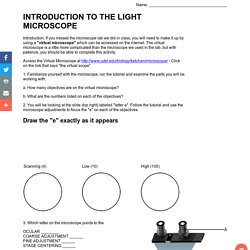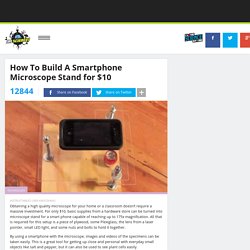

Virtual Lab: Microscopy Virtual Lab. Join the Microscopy lab and learn about the different types of microscopy to understand the mechanisms behind.

You will be trained in light microscopy, transmission electron microscopy and fluorescence microscopy. Use magnification In the Microscopy lab, you will be presented with chicken intestinal slides that have been stained with Anilin, Orange G and Fuchsin. Using the 5x magnification, you will identify the villus, and then proceed with higher magnifications to identify smooth muscle, extracellular tissue, epithelial cells, Goblet cells and the nuclei.
Try out the electron microscope Electron microscopes can be used to visualize objects that are too small to see when using a light microscope—for example the microvilli, mitochondria and the junctions between cells. Learn about fluorescence staining techniques You will learn about fluorescence staining techniques and how it can be used to visualize specific structures. Microscope Introductory Lab - Virtual. Name: ___________________________________ Introduction: If you missed the microscope lab we did in class, you will need to make it up by using a "virtual microscope" which can be accessed on the internet.

The virtual microscope is a little more complicated than the microscope we used in the lab, but with patience, you should be able to complete this activity. Access the Virtual Microscope at - Click on the link that says "the virtual scope" 1. Familiarize yourself with the microscope, run the tutorial and examine the parts you will be working with. Microscope Activity. UD Virtual Compound Microscope. How To Build A Smartphone Microscope Stand for $10. Obtaining a high quality microscope for your home or a classroom doesn’t require a massive investment.

For only $10, basic supplies from a hardware store can be turned into microscope stand for a smart phone capable of reaching up to 175x magnification. All that is required for this setup is a piece of plywood, some Plexiglass, the lens from a laser pointer, small LED light, and some nuts and bolts to hold it together. By using a smartphone with the microscope, images and videos of the specimens can be taken easily. This is a great tool for getting up close and personal with everyday small objects like salt and pepper, but it can also be used to see plant cells easily. The video provides full instructions, but if you need a pictorial step-by-step guide, Instructables user kmyoshino has you covered here.
[Hat tip: kmyoshino via Instructables] McGraw-Hill Virtual Biology Lab. Virtual Labs. What is Life HOME.
Biomolecules. Cell transport. Cell structure. Unit Planner Sample: The Nature of Biology « i-Biology. I’ve been trying to do a bit of Autumn cleaning on the site, as well as working on planners and curriculum jobs as MYPCo here at school.

As a result, I’ve done a lot of reading of new IB documents (Concept-based learning, Approaches to Teaching and Learning etc) and review of older or more fundamental ones (Principles to Practice and so on). Anyway, taking all this into consideration, I figured the unit planner was due an update and wanted to make one more useful for Biology. Here is an example: For more (and a blank template), head over to the Unit Planning page. This is not an official IB product, so please treat it with due diligence. Like this: Like Loading... MYP HS Science & IBDP Bio teacher, HOD Science & MYP Coordinator at Canadian Academy, Japan. Science Biology: The Dynamics of Life 2004 - Section Launcher Movies. BioBlitz Educational Resources Information, Facts. ASU - Ask A Biologist.